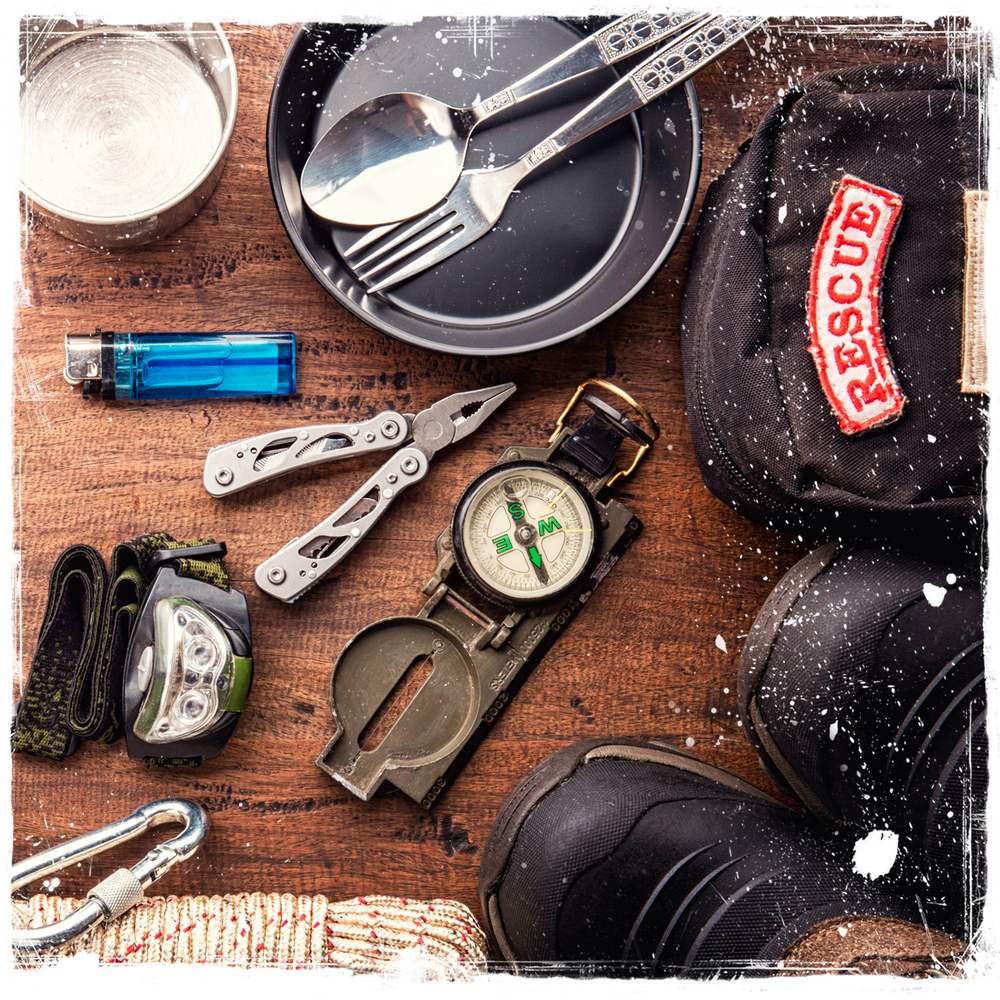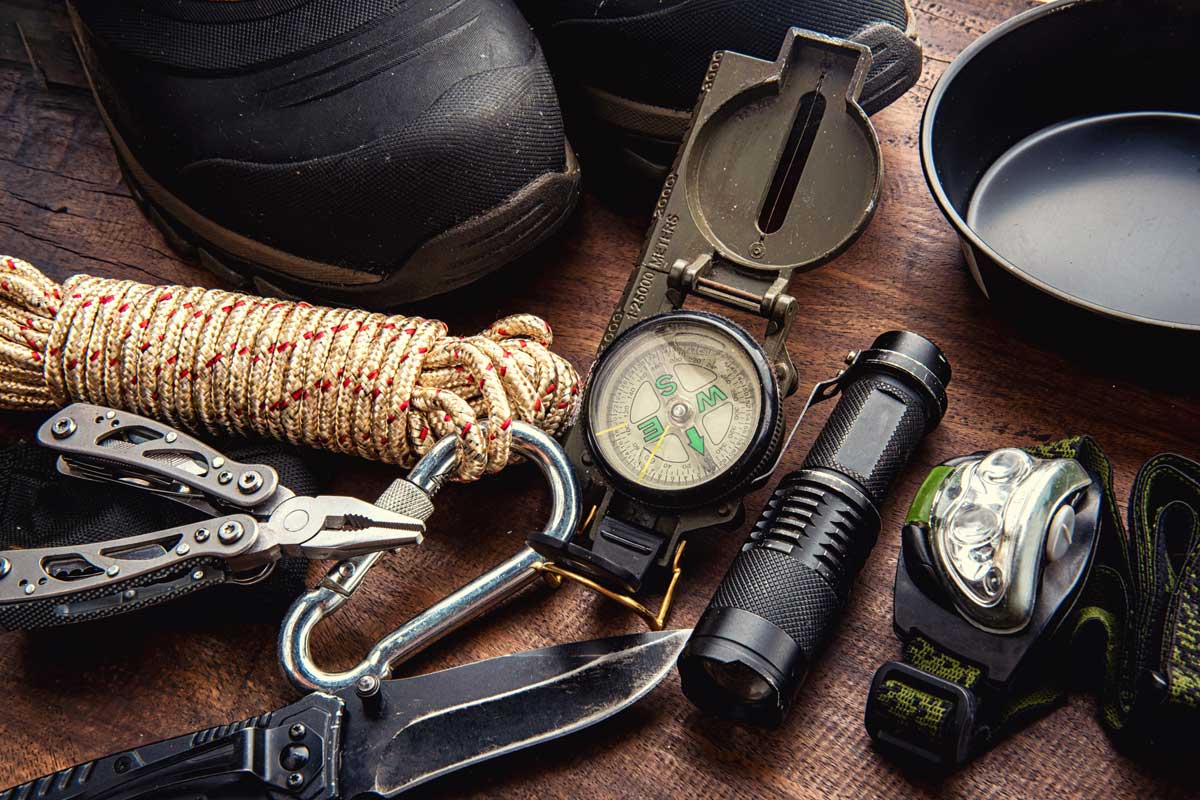A hot cup of tea to wash down the sunset while the fire roars, the birds sing, and the moon peeps through a slither of cloud. All before relaxing back into your bed for a night under the stars. But what does your bed look like?
Are you thinking of getting into wild camping? Perhaps you're at the start of your journey as a prepper and need a mobile shelter for your go-bag or survival kit? Or maybe you want to build in the woods and sharpen your bushcraft skills? You need a shelter and a sleep system, but which setup suits your needs? Read on.
For this article we're going to look at the following carriable wild camping shelter options:
- Tent.
- Bivi bag and tarp.
- Hammock and tarp
And also the following items to make you bed warm and comfortable:
- Sleeping mat
- Sleeping bag
Tent
Let's kick off with the shelter that everyone is familiar with. It's warm, reliable, wind proof, and it can be a lightweight option. Ladies and gentlemen - the tent.
Season Rating
A lot of gear comes with a season rating and this is no different for tents.
- 2 season = spring and summer.
- 3 season = spring, summer and autumn.
- 4 season = spring, summer, autumn and winter.
The thermal performance of the material, the strength of the material, the strength of the poles (unless it has an inflatable structure), the strength of the design, and closeable air vents are all things to consider if you want to camp in a lightweight tent in winter.
Sizes
Some wild campers like to use tents with 1 extra person space for comfort. So if they're a solo camper, that would mean buying a 2 man tent, although this often isn't necessary and a lot of 2 man tents are designed for 2 people, plus their rucksacks and boots. Each to their own. Take a look at the tent's dimensions diagram and see if you can fit everything in there comfortably. Good head space whilst sitting up inside of the tent is also something to bear in mind. Oh and don't forget about space for your dog if you have one!
Back Packing Tents and Mountain Tents
You'll notice that in some shops they have the above categories of tents but what's the difference?
Backpacking tents, you guessed it, pack on your back. But some backpacking tents might only be suitable for lower altitudes and calmer climates. This is the type of tent you'd use whilst hiking in the South of Spain.
A mountain tent is designed to be sturdy in a storm and perform well thermally, but at the size of 1-2 man this should also pack on your back easily and be lightweight. This is usually the pricier option of the 2.
Hot TentingThis is a real treat in the winter. We're talking about smaller hot tents here - something like a 1-4 man tent with a stove jack to stick the stove's flue through. The Polish army's canvass Lavvu is a favourite amongst many wild campers and it's something we easily sell when we get hold of them here at Sgt Preppers.
However, there are many other lighter options which are more suitable if you plan on being far from your car, because don't forget you need to carry the stove and possibly a centre pole for the tent if you can't fashion one from nearby woodland. Check out the ' Onetigris Smokey Hut Chimney Tent'. There's nothing quite like being toasty outdoors in the middle of winter and making a cup of tea on the stove.
Tent Pros and Cons
Pros:
- Free standing structure. Very suited to a mountain where there aren't many trees here in the UK.
- Warm
- Reliable shelter in a storm.
- Bug proof.
- Can be just as lightweight as other options.
Cons:
- Takes up a larger area of ground than other options.
- Requires flat ground.
- Can be expensive (4 season mountain tents).
- You can't see the stars!
Tent Recommendations
The Terra Nova Voyager is an expensive option but worth every penny. It's a 4 season, 2 man mountain tent which is incredibly lightweight, warm and solid. This tent has been tried and tested for 25 years and is a very popular option. Excellent bit of kit.
A Vango Banshee 200 Pro is a cheaper option but still great. It's a 3 season, 2 man backpacking tent and it will see you through the majority of nights here in the perfect UK climate.
Bivi Bag and Tarpaulin
Next up we have arguably the most versatile option and a real gem if you find yourself slowly turning into 'Grizzly Adams'. Ladies and gentlemen - the bivi and tarp.
But is it a bivi, a bivy or a bivvy? We have no idea. Anyway...
What is a Bivi Bag?
A bivi bag is a waterproof bag which you, your sleeping bag, and in some cases your sleeping mat go inside of. Some bivis can be zipped up in bad weather and have a small pole structure near where your head goes to keep the bag off your face. Other bivis just function as a bag and don't cover your face.
You can use a bivi bag by itself, but we recommend that you bring a tarpaulin or 2 with you, especially if you're scaling a mountain, because unless you're under a tree or a rock, a bivi bag on it's own is a sorry place to be in a storm!
That saying, a bivi bag is great for really putting you out there in the great outdoors. It's a very lightweight option and a reliable bit of kit to bring in any situation.
The Tarpaulin AKA The Tarp
Versatile, ventilated, warm with a fire, and something to be proud of once you've set it up using nothing but your skills and your bare hands. This is a piece of kit that we encourage everyone to get familiar with. It can be set up at head height to work under or low to the ground as a storm shelter. For the preppers out there, it's a great option for your go-bag/survival kit. It's lightweight, it can be used as a ground sheet instead of a shelter, and it can be used to collect rain water.
Tarps come in all shapes and sizes. The most versatile is a 'flat tarp' which is a square or rectangular sheet made from either nylon, ripstop polyethylene, or even waxed cloth. There are many ways to set up a flat tarp, some of which are shown in the image. Stay tuned for the Sgt Preppers videos demonstrating flat tarp setups.
You can also get 'shaped tarps' which are strung up in a more specific way. The advantages of a shaped tarp are that they're easier to tie up for beginners, and the have less fabric than a flat tarp because of their catenary curves. Some shaped tarps can provide ideal long length coverage for a hammock as shown below.
Some accessories that'll help you with your tarp setup are: paracord, pegs, bungee, karabiner clips, ridge poles and/or walking sticks. If you're where there aren't any trees or rocks, you're going to need to use ridge poles or walking sticks to prop up your 'ridgeline'. Or for the bike packers out there -use your wheels. Or for the canoers and kayakers out there - use your paddles. Anything goes!
Bivi and Tarp Pros and Cons
Pros:
- Very versatile
- Can be set up next to the fire for a warm night sleep.
- A low tarp can be a good storm shelter.
- Less fussy than a tent when it comes to finding flat ground.
- Fun
- You can see the stars!
Cons:
- Tarp setups require skills and knowledge.
- You need to know some knots, setup options, and you need to understand wind direction.
- Not bug proof unless you zip up your bivi. You can also get a mosquito net to string up underneath your tap.
- Flat ground is still necessary to an extent.
- Nylon tarps need to be kept upwind and a sensible distance from the fire.
Bivi and Tarp Recommendations
A solid bivi bag is the British Army Bivi. It's very spacious, robust, simple, stealth and affordable.
The Rab Siltarp 2 is an extremely lightweight nylon tarp designed for adventure races but can be used wherever you like. Great up a mountain in the UK. Keep it upwind from your fire if you're in the woods. Size = 2.4 x 3.0m which is ideal for 2 people.
An affordable tarp, but with uncompromised quality is the DD3 by DD Hammocks. It's medium weight as far as tarps go, but it's an all rounder, and sometimes it's nice to have a cheaper bit of kit if it's going to take some abuse. But again, keep it upwind from your fire because this is nylon. Size = 3.0 x 3.0m
Hammock and Tarp
Arguably the coolest cucumber in town can be found in one of these...but in the woods? Ladies and gentlemen -the hammock and tarp.
Here in the beautiful North of Albion you will find a lot of our woodland next to rivers, which can make it more difficult to find flat ground. If that's the kind of landscape you're dealing with then a hammock is an ideal way to go. A hammock is also subjectively a reliably comfortable option and can be lightweight too.
First you set up the tarp shelter, usually as a diamond instead of a square to get the most coverage of your hammock. Then you string up the hammock, and to do this most people use tree straps, karabiner clips and paracord. There are plenty of videos out there on YouTube which show you how to setup a hammock and tarp, but stay tuned for future Sgt Preppers videos showing you our setups.
You can get mesh, parachute material and waterproof material hammocks. Mesh is lightweight, it ventilates well, but is thought to be less comfortable. Waterproof hammocks lack ventilation but they're a warmer and dryer shelter. Parachute material is somewhere in the middle of the other 2 options and is probably the most common type of camping hammock. Some hammocks come with a mosquito net.
Something important to consider with a hammock is insulation. As well as your sleeping bag, to keep warm in the winter in a hammock you'll need your sleeping mat at the very least, but some wild campers add a wool blanket inside the hammock or an underblanket which hangs below the hammock. We've seen some people use a car windscreen shield as well as their mat and blanket because it's good for reflecting body heat, and it's also lightweight.
A square flat tarp rather than a rectangular one might make your life easier for setting the tarp up as a diamond, but shaped tarps can also be good over your hammock.
Hammock and Tarp Pros and Cons
Pros:
- Comfortable.
- Can be near the fire, though you are a lot more limited here than with a bivi.
- Off the ground - good in wet conditions.
- Doesn't require flat ground.
- Fun.
- You can see the stars!
Cons:
- Needs woodland - not suitable for UK mountains and moorland.
- Requires skill for the hammock and tarp setup.
- Not bug proof unless you're using a mosquito net.
- Tarps and hammocks need to be kept upwind and a sensible distance from the fire.
- We say it's comfortable but some people find that they can't get on with a hammock.
Hammock Recommendations
The DD SuperLight Hammock is a lovely piece of kit and if you combine that with their mosquito net and tarp, the package can be less than 1kg. That's very light.
Sleeping Mats
As a beginner, I didn't realise that the sleeping mat is just as important as the sleeping bag when it comes to keeping warm on a night. With a sleeping mat you've basically got 2 options:
- Foam.
- Self-inflating mats.
Foam mats are cheap but will keep you warm. They're comfortable if you can find soft, flat ground. They're bulky and need to be on the outside of the pack. However, they're a perfect seat for around the fire and they can be used as a changing mat.
Self-inflating mats can be bulky but some will fit inside of your rucksack. Self inflating mats are more comfortable than foam mats and they're more likely to give you a good night sleep if you find yourself lying on uneven ground. Self inflating mats will break the bank more than a foam mat but for good reason.
Sleeping Mat Recommendations
Any thick, decent quality foam mat will do the trick. There's some rubbish out there in the supermarkets but some alright mats too. Have a feel of the material and go with your gut.
An excellent self inflating mat is the Therm-a-Rest NeoAir XTherm. You can lie on snow with this and still be warm. It's surprisingly robust too! Highly priced but worth it.
Sleeping Bags
You get a choice of insulation with a sleeping bag: duck down or synthetic, each with its advantages. You won't beat a duck down bag for warmth and comfort, but when a duck down bag gets wet it doesn't hold the heat like a synthetic bag does.
Synthetic bags can be warm and comfortable though too. Both options are good, it's just whatever suits your needs. Personally I run with synthetic bag because we live in a wet country and if I was to accidently drop my kit into a stream then my synthetic bag would hold its heat better - but I've never wet a sleeping bag in my life... honestly!
Square sleeping bags have a squared footspace and are comfortable but the extra material adds slightly extra bulk. A 'mummy' sleeping bag hugs the body close by narrowing at the feet, making it a warmer but tighter option than a square sleeping bag.
We recommend using a sleeping bag liner which will add a little warmth and stop you needing to wash your sleeping bag as often. You can get silk and polyester sleeping bag liners.
Why not add a wool blanket to your sleep setup? It can turn a 3 season sleeping bag into a 4 season, it can be worn around the fire, or it can be used as a ground sheet. Check out Woolymammoth Blankets or a Dutch Army Blanket.
Sleeping Bag Recommendations
A cheap sturdy option is to take the army surplus route and go for a French Military Sleeping Bag. Comfort and weight are sacrificed here for a sleeping bag that's warm enough to do the job on most winter nights.
An affordable midrange 3-4 season sleeping bag option would be the new Robens Glacier sleeping bag. This is a nice bag!
A pricier option but a beautiful piece of luxury kit is the Yeti Fever Zero Down Sleeping Bag. This compresses small and will keep you toasty in winter. Who needs a house when you've got this thing?
SummarySo to summarise, we have 3 shelters to consider:
- Tent.
- Bivi bag and tarp.
- Hammock and tarp
And also your bed to consider
- Sleeping mat
- Sleeping bag
We hope you found this article useful and we hope it encourages you to get out there and do a bit of wild camping (copyright of the Fell Wanderer!), you know it makes sense.
As long as you're confident that you'll be warm enough and dry enough to get yourself through the night safely, you'll learn exciting new skills whilst connecting with nature, and you absolutely will not regret it!
This is an exciting hobby. Infact, it's more than that - it's also a skillset which could save your life one day, and at Sgt Preppers we are passionate about it.



